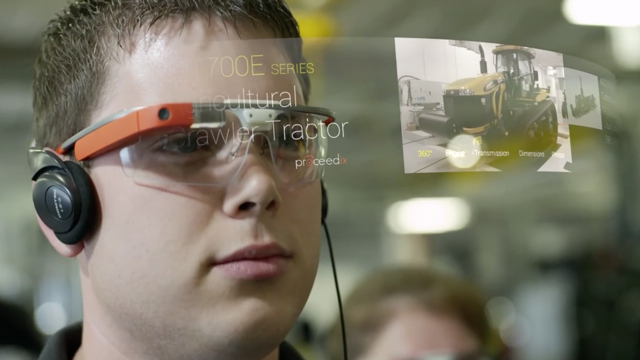Massachusetts Institute of Technology researcher Dr. Matthias Winkenbach has a good idea of how virtual reality could completely change how corporations solve supply chain problems. He believes that in at least three-to-five years away, supply chain managers will rely on augmented and virtual reality to make better decisions more quickly, with the ability to see holograms with visible data via an AR or VR headset. Managers can immerse themselves in remote environments without traveling to physical locations.
The New York Times quotes Winkenbach, who directs MIT’s Megacity Logistics Lab at the Center for Transportation and Logistics, as saying that augmented and virtual reality are a “more rich way” to “visualize information and understand problems.”
In December, we posted a story about AGCO Corp. using Google Glasses to aid in quality checks on equipment (image below). The company plans to expand the program next year, using 3D imagery to help workers weld 30-foot booms to chemical sprayers.
“A few years down the road we believe you could take this functionality anywhere,” Winkenbach said. “You’d just need a decent Internet connection and an AR headset to pull up any … supply chain and logistics data anywhere in the world for whoever wants it.”
At MIT, Winkenbach is currently building a Visual Analytics Lab, “where corporations and researchers could experiment with visualizing supply chain-related data using technologies including augmented and virtual reality.” The lab, which will be open late this year, will be available to corporations and other MIT department researchers.
Before AR and VR can become a solution for supply chain management, notes Winkenbach, they have to succeed among consumers. “Without it catching up on the consumer side, it’s going to be hard … for it to be technologically robust and advanced enough to create value in a corporate environment,” he said.
Flextronics International chief procurement and supply chain officer Tom Linton agrees, calling the potential of AR and VR “enormous.” Because global supply chains are expensive to run, he added, “technologies that could allow supply chain managers to see and experience problems in the field without actually being there could be game-changing.” Still, he noted, “it’s early.”
Forrester Research says that about 14.4 million U.S. workers will use smart glasses in 2025, up from 400,000 this year; companies will spend $3.6 billion on smart glasses in 2025, up from $6 million last year. Indian research firm Markets and Markets predicts that the global 3D imaging market, which includes holograms, will grow from $4.9 billion in 2015 to $16.6 billion by 2020.
Editor’s Note: The image above


No Comments Yet
You can be the first to comment!
Sorry, comments for this entry are closed at this time.